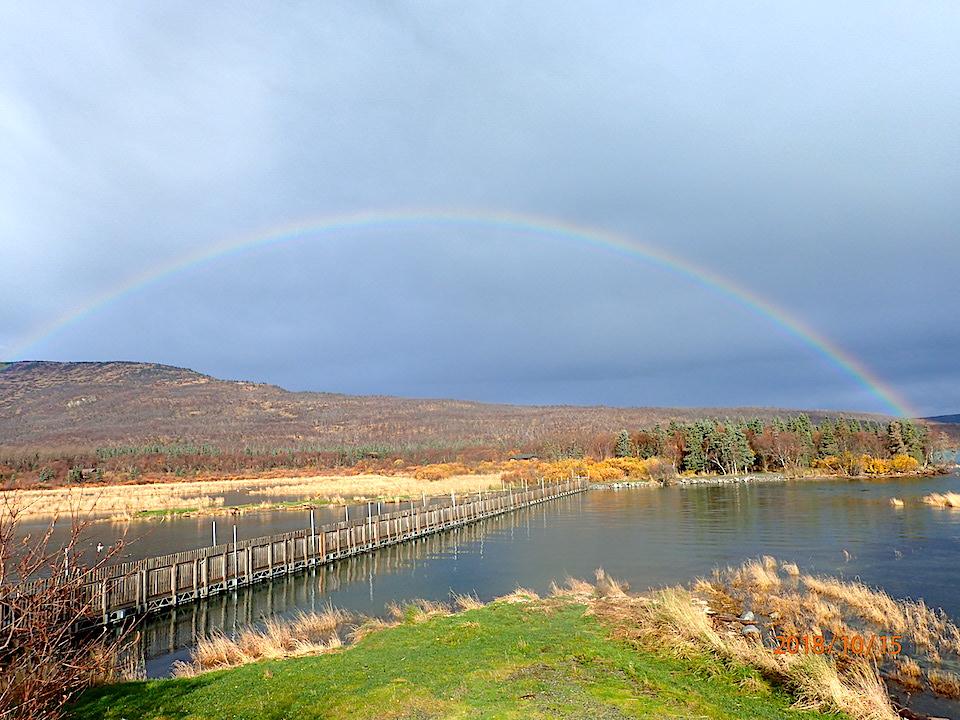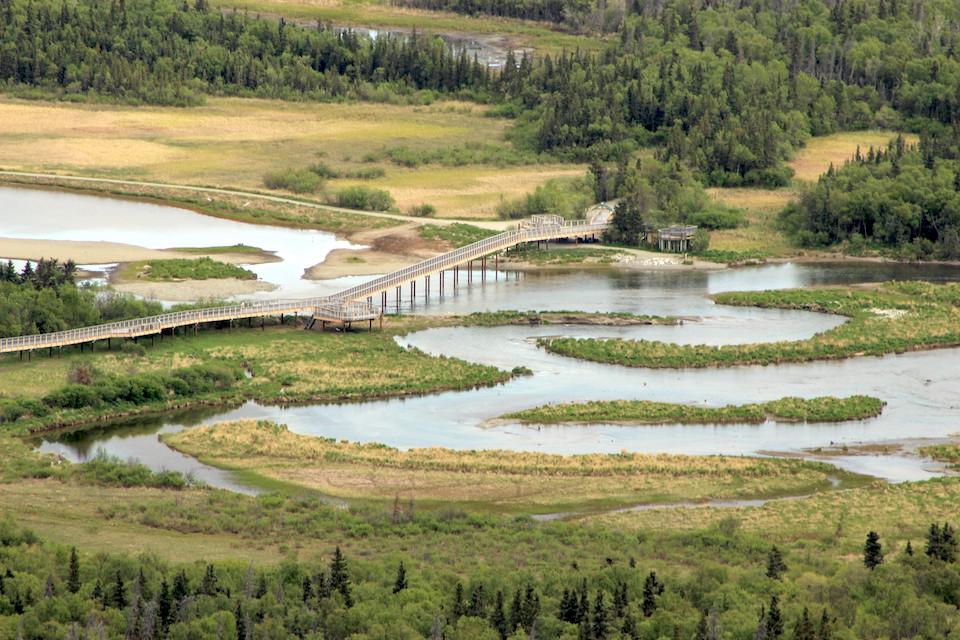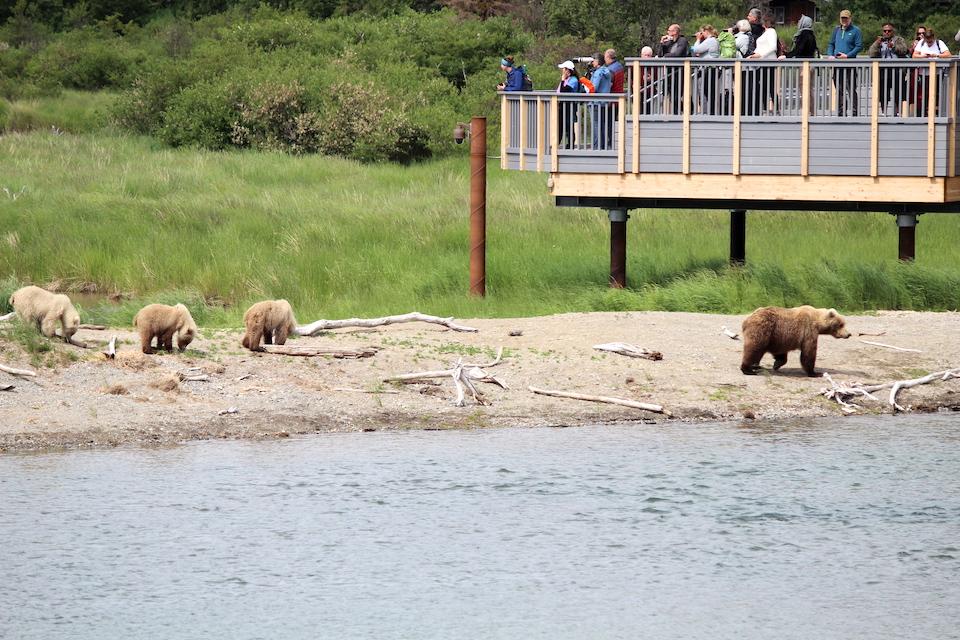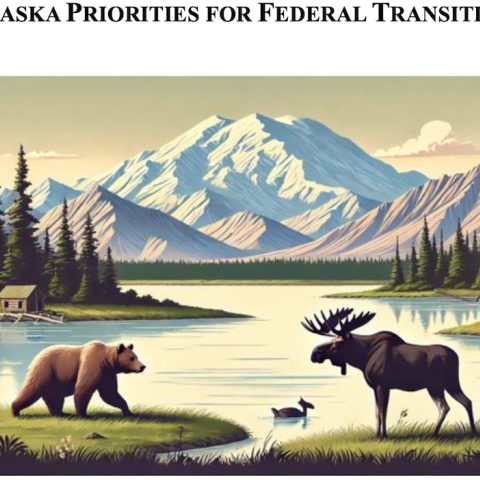
Controversy dogs a nearly $6 million bridge spanning the Brooks River at Katmai National Park/Rebecca Latson file
Editor's note: The National Park Service's decision to spend upwards of $6 million on a bridge spanning the Brooks River in Katmai National Park was controversial throughout the planning stages. The project was condemned by Ray Bane, a former Katmai superintendent, and Dr. Barrie Gilbert, a noted ecologist who has spent decades studying the park's bears and who said the bridge was part of an effort by the Park Service to transform the park into a "destination theme park." But Park Service officials in the end deemed the bridge an essential replacement for the old floating bridge that spanned the river.
"The new bridge will provide safer visitor and employee access from the lodge and campground on the north side of the river to the south," the agency said in November 2016 when it announced the decision to replace the old span. "The southern side of the bridge and boardwalk will end near an existing bear viewing platform, trails to additional bear viewing platforms and the road to the Valley of Ten Thousand Smokes."
The final cost of the bridge that debuted this summer was "around $6 million," according to the Park Service.
A Park Service ranger who witnessed the planning and decision-making stages of the bridge continues to believe the agency made the wrong decision and explains why in this column.
In the notes app on my phone, there is a list of numbers most people would find meaningless: 94, 132, 813, 480, 83, 171, 814, 435, 879. For me, the numbers conjure up memories of a fall evening spent on the Lower Platform at Brooks Camp as bears moved within 50 yards of the floating bridge over the Brooks River and dusk fell.
Four of the numbers indicate the IDs of female bears, who were accompanied by a total of nine cubs between them. Nine adult bears plus nine cubs stood between me, my spouse, and our cabin on the north side of the river. We had canoed across to the south side of the river to access the bear viewing platform, knowing that crossing the river is tricky in fall as bears feed on dead and dying salmon drifting downriver.
Now, as darkness approached, we could not even descend from the platform, as all three exits had bears within 50 yards. I thought it might be the first time ever in seven years of spending time at Brooks Camp that I would be unable to cross the river by foot or boat before dark. As we accepted the possibility of spending a chilly evening on the platform, a brief window emerged as the bears all moved more than 50 yards away from the bridge and the trail. We crossed the bridge swiftly by foot, abandoning the canoe to be retrieved at another time.

The old floating bridge crossing the Brooks River at Katmai National Park/NPS
Time moves to a different rhythm at Brooks Camp, a rhythm I think of as “bear time.” Just as visitors to tropical destinations may find themselves living by island time, where the numbers on the clock don’t matter, it’s often difficult to keep to a precise schedule at Brooks Camp. Particularly during the months of July and September when bear activity is at its highest, you may find that your path to any planned destination is occupied by a sleeping, resting, feeding, running, playing, or mating bear. These situations, known as “bear jams,” are infinitely preferable to traffic jams on a highway. In a 2006 survey of visitors to Brooks Camp, 48 percent of respondents said that bears blocking access to facilities added to their experience, while only 7 percent felt it detracted.
Despite this, in 2009 Katmai National Park and Preserve issued a draft Brooks River Visitor Access Draft Environmental Impact Statement proposing an elevated bridge over the Brooks River, stating that the bridge was needed for the following reasons:
- To improve visitor and employee safety, reducing the risk of human-bear conflicts
- To provide dependable access for the phased relocation of facilities and park concession operations
- To protect key park resources in the Brooks River area, including brown bears, salmon and trout, and cultural resources
- To improve visitor experience in the area.
The EIS didn’t include evidence or data to support these assertions.
Interactions between bears and people are common at Brooks Camp due to the placement of facilities between Lake Brooks and Naknek Lake. Why would interactions between bears and people in the river corridor be any more dangerous than interactions on the campground trail, outside lodge cabins, or along the trail to Brooks Falls? One could argue that interactions near the river mouth were less likely to be dangerous than those in other locations due to the presence of NPS staff and the fact that people were typically walking in larger groups than elsewhere in Brooks Camp.

An aerial view of the new bridge crossing the Brooks River at Katmai National Park/NPS
The reality is that the elevated bridge was never about reducing bear-human conflict. Instead, it was about reducing human-human conflict.
The NPS staff tasked with managing traffic near the bridge and enforcing the park regulation about not approaching bears closer than 50 yards was frequently challenged by other NPS staff who felt that work tasks and personal priorities should take precedence over adhering to wildlife distance regulations. The staff of Brooks Lodge, operated by Katmailand, Inc, would grow frustrated about lengthy bridge closures due to the potential for delaying flights taking off from the north side of Brooks River. Commercial operators attempting to conduct 4-hour bear viewing trips in a place governed not only by bears but also by unpredictable weather fumed about the requirement for visitors to attend bear orientations in the visitor center on the north side of the river while the bear viewing platforms could only be accessed from the south side.
Creative problem-solving would have resolved many of these situations, such as taxiing planes to the south side of the Brooks River for take-off or rescheduling flights to depart from Lake Brooks instead. NPS staff could have planned work schedules to remain on one side of the river for the duration of the work day rather than attempting to cross the river multiple times over the course of the day.
The failure to think creatively and adapt to bear time at Brooks Camp has resulted in the construction of the massive, multi-million dollar bridge in a location where visitor facilities are open less than four months a year. The bridge is not just a bridge, however. Instead, the park has constructed multiple new viewing platforms that now impact both the north and south sides of Brooks River and increase the potential for bear-human conflicts.
Where there was once a path obscured by vegetation and a low profile, 225-foot-long bridge floating on pontoons, a 10- to 12-foot high bridge now extends for 1,200 feet. The noise and visual impacts of human traffic, including motorized vehicles, extend much farther upriver than before.
On a recent visit to Brooks Camp, I spent nearly two days watching bears and people from the new elevated bridge. While many visitors are thrilled with the new viewing locations, I observed several instances where human traffic on the bridge seemed to impact the behavior of bears below. On one occasion, a male bear courting a female stopped short of passing under the bridge while looking up at the people above. He stalled for several minutes before taking a different route further away from the people, and didn’t resume his pursuit of the female once he finally crossed under the bridge.

The new bridge has two viewing platforms for park visitors/NPS
In addition to people on the bridge impacting bear behavior, people on the ground are also impacting it. NPS staff no longer manage foot traffic on the trail to “the corner,” where the camp trail meets the north side of Brooks River. While there, I observed people strung out along the trail between the corner and the bridge. One woman was reclining and napping under the bridge in a place frequently traversed by bears. On the opposite side of the river, several photographers were on the ground beneath the viewing platform formerly known as the “Lower Platform.” Anglers were fishing in the river itself.
When bears wandered down the trail to the corner to access the river, chaos ensued as people and bears scattered in every direction. Where a ranger used to be present to provide guidance and direction to people in these circumstances, people were now on their own to navigate the situation. So much for improved visitor safety.
At a ribbon-cutting ceremony for the new bridge, an aide to U.S. Sen. Lisa Murkowski, R-Alaska, proudly proclaimed that “bear jams were a thing of the past.”
The statement was both untrue and reflected a profound ignorance about the bear viewing experience at Brooks Camp. A few days later, on the 4th of July, visitors exiting the bridge on the south side of the river were unable to proceed up the road towards the Brooks Falls trailhead due to a bear jam caused by two subadult bears sleeping along the road.
A few hours later, a significant bear jam closed down access to most of the trails through Brooks Camp on the north side of the river due to nervous spring cubs and their mother, who treed themselves in the midst of the Brooks Lodge facilities. While attempting to circumvent the bear jam by taking the widest possible route around the tree where the bears were, my spouse and I ended up crammed into a tiny lodge cabin with four others while NPS bear management staff attempted to clear and quiet a large enough area within Brooks Camp for the bears to feel comfortable coming down from the tree. This is nearly an impossible task, however, as arriving and departing floatplanes taxied to the beach less than 50 yards from the bears, noisy all-terrain vehicles drove to pick up luggage, and people milled about on multiple trails outside the lodge and visitor center.
As long as Brooks Camp facilities are located within prime bear habitat adjacent to Brooks River, Naknek Lake, and Lake Brooks, bear jams will remain part of the bear-viewing experience. The lack of limits on visitation numbers and the close proximity of so many people to a large population of brown bears means that potential for bear-human conflict will continue, especially since people have unrestricted access to all areas of Brooks Camp except for the area immediately adjacent to Brooks Falls.
In my opinion, the NPS is failing in its mandate “to conserve the scenery and the natural and historic objects and the wild life therein and to provide for the enjoyment of the same in such manner and by such means as will leave them unimpaired for the enjoyment of future generations.” Our human inability to live by bear time while enjoying one of the greatest wildlife viewing spectacles in the world is shaping a Brooks River where only the bears most habituated to the presence of humans will survive.
What will we have lost when we can no longer wait in the hushed silence of a darkening fall evening surrounded by bears, waiting for our turn to move without disturbing their presence?



 Support Essential Coverage of Essential Places
Support Essential Coverage of Essential Places







Comments
How is the weather up there on the pulpit?
People do stupid things and that will continue no matter what NPS builds
i think the EIS did speak to some if those assertions. You disagree and that is fine. At the end of the day we go with the decision and if we can't live with it we leave the agency.
Six million dollars for a seasonal bridge that the average American will never be able to afford to visit? The author is wise to remain anonymous; the NPS Office of Whistleblower Crucifixion will not be pleased.
Is this column an anonymous one?
Yes, for understandable reasons.
Since the building of the new bridge, I have seen people throwing things at Bears, photographers with enormous telephoto lenses chasing Bears on the Lower River, groups of people crowding in on Bears. These disgusting spectacles are apparently going to continue until some innocent Bear pays the price with its life. SHAME ON YOU, NPS!!
Excellent article, it is very scary what is happening this year. I went there in2016 and the people were successfully controlled by the rangers and our orientation that "people are not free to do what they want, bears are free". thank you
Thank you for writing this & letting people know how it really is & your experienced opinion. I would love to visit BF but never will for several reasons. I can see more than a visitor on the cams & I don't want to disturb the bears natural habitat & their habits. I don't think fisher people should be allwoed to fish at all in the Brooks River. There are thousands of other places to fish. They definitely are disturbing the bears even at 50 ft. No Bear should become habituated to humans!
I've lived in the area my whole life and have witnessed first hand the changes that have taken place. Big business has changed this pristine and remote place. The bears should always be first, not tourists, airplane schedules or even the park service. Once changes and modernization occur I fear it will not stop. For those who haven't seen it you have no idea what the term "wild" really means.